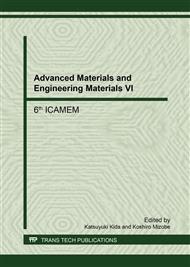[1]
Y.P. Huang, B.P. Zhang, G.W. Xu, W.T. Hao, Swelling behaviours and mechanical properties of silk fibroin-polyurethane composite hydrogels, Compos. Sci. and Tech. 84 (2013) 15-22.
DOI: 10.1016/j.compscitech.2013.05.007
Google Scholar
[2]
H. Shulha, C.W.P. Foo, D.L. Kaplan, V.V. Tsukruk, Unfolding the multi-length scale domain structure of silk fibroin protein, polymer. 47 (2006) 5821-5830.
DOI: 10.1016/j.polymer.2006.06.002
Google Scholar
[3]
R.C. You, Y.M. Xu, G.Y. Liu, Y. Liu, X.F. Li, M.Z. Li, Regulating the degradation rate of silk fibroin films through changing the genipin crosslinking degree, Polym. Degrad. Stab. 109 (2014) 226-232.
DOI: 10.1016/j.polymdegradstab.2014.07.029
Google Scholar
[4]
C.H. Wang, C.Y. Hsieh, J.C. Hwang, Flexible organic thin-film transistors with silk fibroin as the gate dielectric Adv. Mater. 23 (2011) 1630-1634.
DOI: 10.1002/adma.201004071
Google Scholar
[5]
A. Vasconcelos, A.C. Gomes, A. Cacaco-paulo, Novel silk fibron/elastin wound dressings, Acta. Biomater. 8 (2012) 3049-3053.
DOI: 10.1016/j.actbio.2012.04.035
Google Scholar
[6]
Q.S. Zhang, X.Z. Wang, Q.F. Mu, P.F. Liu, S.J. Jia, L. Chen, X.Y. Zhang, K. Wang, Y. Wei, Genipin-cross-linked silk sericin/poly(N-isopropylacrylamide) IPN hydrogels: color reactoin between silk sericin and genipin, pore shape and thermoresponsibility, Mater. Chem. Phys. 166 (2015).
DOI: 10.1016/j.matchemphys.2015.09.037
Google Scholar
[7]
H. Teramot, K. Nakajima, C. Takabyashi, Chemical modification of silk sericin in lithium chloride/dimethyl sulfoxide solvent with 4-cyanophenyl isocyanate, Biomacromolecules. 5 (2004)1392-1398.
DOI: 10.1021/bm034537r
Google Scholar
[8]
A. Gonzalez, M.C. Strumia, C.L.A. lgarzabal, Cross-linked soy protein as material for biodegradable films: synthesis, characterization and biodegradation, J. Food Eng. 106 (2011) 331-338.
DOI: 10.1016/j.jfoodeng.2011.05.030
Google Scholar
[9]
E.S. Sashina, G. Janowska, M. Zaborski, A.V. Vnuchkin, Compatibility of fibroin/chitosan and fibroin/cellulose blends studied by thermal analysis, J. Therm. Anl. Calorim. 89 (2007) 887-891.
DOI: 10.1007/s10973-006-7676-1
Google Scholar
[10]
L. Zhou, Q. Wang, J.C. Wen, X. Chen, Z.Z. Shao, Preparation and characterization of transparent silk fibroin/cellulose blend films, Polymer. 54 (2013) 5035-5042.
DOI: 10.1016/j.polymer.2013.07.002
Google Scholar
[11]
M.A. Guler, M.K. Gok, A.K. Figen, S. Ozguus, Swelling, mechanical and mucoadhesion properites of Mt-starch-g-PMAA nanocomposite hydrogels, Appl. Clay Sci. 112-113 (2015) 44-53.
DOI: 10.1016/j.clay.2015.04.019
Google Scholar


